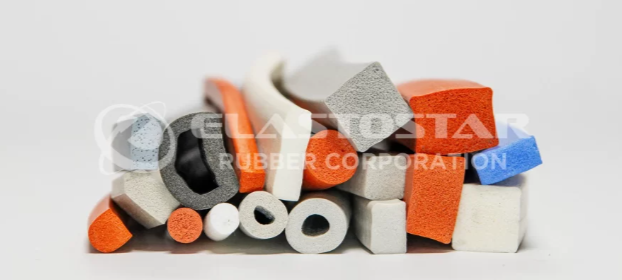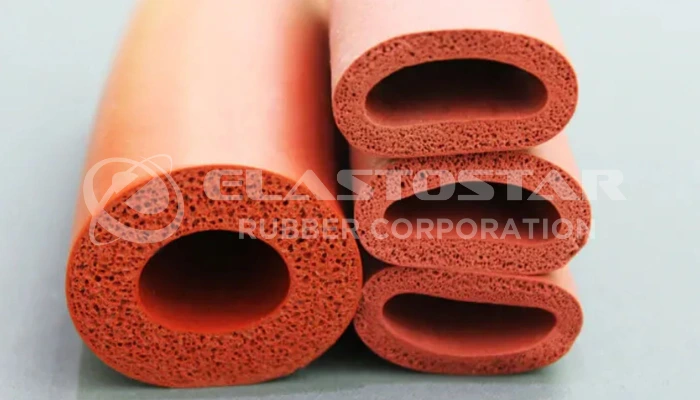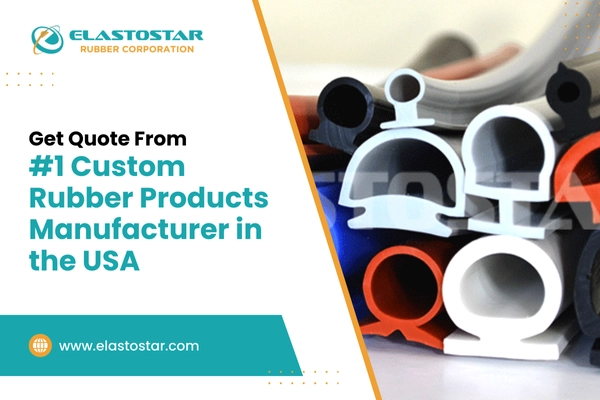It can be confusing to understand the differences between sponge and foam rubber. Rubber foam has special ingredients that create a light and airy structure, perfect for cushions and insulation.
On the other hand, sponge rubber is more elastic and dense, making it great for blocking liquids and gases in seals and gaskets.
This article will help you learn about the unique qualities of each material and guide you in choosing the right one for your needs..
Table of Contents
What is Silicone Sponge Rubber?

Silicone sponge rubber is crafted by infusing silicone with air to create a lightweight, elastic material. This versatile rubber comes in two primary forms – open-cell, which is softer and more adaptable, and closed-cell, which is denser and prevents the passage of water and air.
Properties of Silicone Sponge Rubber
This material is renowned for its ability to endure temperatures ranging from -60°C to 230°C, making it ideal for demanding environments. It offers excellent compression and recovery, characteristics vital for applications requiring durable sealing solutions like silicone foam gaskets.
Common Applications of Silicone Sponge Rubber
Silicone sponge rubber is pivotal in various applications. In the automotive industry, it is used to make silicone foam gaskets that seal engine parts against harsh conditions. For consumer products, the open-cell version enhances comfort as the main component in sponge rubber mattresses. In contrast, the foam sponge material is commonly found in insulation panels and protective padding, providing cushioning and shock absorption.
Benefits of Silicone Sponge Rubber
The adaptability of silicone sponge rubber to different environments makes it valuable for numerous industrial and consumer applications. Its long-lasting resistance to environmental factors like weathering and oxidation ensures prolonged utility without frequent replacement. Its safety features, including non-toxicity and flame retardance, make it a safe choice for various applications.
Incorporating silicone sponge rubber into products ensures a blend of durability, functionality, and safety, catering to the rigorous demands of modern industrial and consumer needs
Read more- Sponge Silicone Rubber Products: Benefits & Applications
What is Foam Rubber?

Foam rubber is a soft, elastic material that incorporates air into rubber compounds to create a spongy texture. It comes in two primary forms: open-cell, which is permeable and breathable, and closed-cell, which is more compact and moisture-resistant.
Properties of Foam Rubber
Foam rubber is characterized by its light weight and excellent impact absorption, making it ideal for safety and cushioning applications. It offers good insulation properties, both thermal and acoustic, and is suitable for various settings. This material is also highly flexible, easily conforming to different shapes and enhancing its versatility in manufacturing.
Common Uses of Foam Rubber
Foam rubber is extensively used in various sectors. In commercial furniture, foam rubber blocks are employed for padding in seats and backs, providing comfort and support. It’s also a mainstay in mattresses where its ability to blend support with softness improves sleep quality.
In the cleaning industry, the foam rubber sponge is a popular choice for its ability to absorb liquids and conform to surfaces, making it effective for many cleaning tasks.
Advantages of Foam Rubber
The primary advantages of rubberized foam include its adaptability and cost efficiency. This material can be customized in different densities and firmness levels to meet specific product requirements. It is also water- and mold-resistant, contributing to its durability and suitability for indoor and outdoor uses.
Furthermore, its shock-absorbing capabilities are essential for protecting contents in packaging and transportation, ensuring longevity and functionality.
Comparison of Physical Properties
The table below compares the density, temperature resistance, and durability of silicone sponge rubber and foam rubber, highlighting their impacts on performance in sealing and insulation applications.
| Property | Silicone Sponge Rubber | Foam Rubber |
| Density | Higher density, more compact structure | Lower density, softer and more compressible |
| Temperature Resistance | Excellent, ranging from -60°C to 230°C | Moderate, effective from -40°C to 100°C |
| Durability | Highly durable, resistant to weather, UV, and ozone | Lower density, softer, and more compressible |
Impact on Performance
Sealing Applications
- Silicone Sponge Rubber is ideal for demanding environments where a robust silicone foam gasket is necessary due to its higher density and superior temperature resistance. It is commonly used in automotive, aerospace, and industrial settings.
- Foam Rubber: More suitable for indoor or controlled environments where extreme conditions are less of a concern. It provides effective sealing at a lower cost but may not handle severe temperature variations and environmental factors.
Insulation Applications
- Silicone Sponge Rubber: Highly effective in thermal and acoustic insulation, particularly in settings requiring durability against extreme temperatures and conditions.
- Foam Rubber: Frequently used for thermal and sound insulation in commercial buildings, providing a cost-effective solution with good performance in standard conditions.
How Are Silicone Sponge and Foam Rubber Manufactured?
The production methods for silicone sponge and foam rubber involve distinct processes affecting their properties and environmental impact.
Silicone Sponge Rubber
Manufacturing Process
Silicone sponge rubber is produced using a process that combines liquid silicone with a foaming agent. The mixture is then subjected to high temperatures that activate the foaming agent, causing the silicone to expand into a sponge foam structure.
This structure can be fine-tuned to create either open-cell or closed-cell silicone sponge rubber for specific applications such as foam weather stripping.
Environmental Impact
The high curing temperatures required to produce silicone sponge rubber are energy intensive. However, silicone is chemically inert, meaning it doesn’t emit harmful chemicals during production or use, making it a safer environmental choice. Its durability also means it doesn’t need to be replaced as often, reducing its long-term environmental footprint.
Foam Rubber
Manufacturing Process
Foam rubber is typically manufactured using a slabstock or molding process. During slabstock production, a mix of liquid components is poured onto a conveyor, which reacts and rises into a foam. This foam sponge material is then cured as it travels and is later cut to size. In molding, the mix is injected into a mold, expanding to form the final product.
Environmental Impact
Producing foam rubber can involve petrochemicals and may release volatile organic compounds (VOCs), harming the environment and human health. However, newer methods that use water-based or less harmful agents to create rubber foam sheets are being developed, significantly reducing VOC emissions.
Differences in Environmental Impact
- Silicone Sponge Rubber has a higher initial environmental impact due to the energy required for production. Still, its inert nature and durability make it more sustainable in the long term.
- Foam Rubber might use less energy during production, but the materials and methods can be more damaging due to chemical emissions unless eco-friendly techniques are employed.
Understanding these manufacturing differences is essential for choosing materials that align with environmental sustainability goals and specific industrial needs.
Cost and Availability Of Sponge Rubber vs. Rubber Foam
Silicone Sponge Rubber
This material is generally more expensive due to its high-quality production process and materials. The durability and resistance to harsh conditions make sponge rubber suitable for specialized applications where its longevity offsets the higher upfront cost.
Foam Rubber
Known for its affordability, rubber foam is produced using less costly materials and simpler techniques, making it a cost-effective option for various commercial and consumer applications. Its broad availability enhances its appeal to industries managing tight budgets while requiring reliable performance.
Ultimately, the choice between sponge rubber and rubber foam will depend on the project’s specific performance requirements and financial considerations, as well as their accessibility in the market.
What are the Pros and Cons of Rubber?
Pros and Cons of Sponge Rubber
Silicone Sponge Rubber has several strong points. It can handle high and low temperatures, from -60°C to 230°C, making it great for tough environments. It’s also durable, resisting damage from sunlight, ozone, and bad weather, so sponge rubber is often used outdoors.
This material stays flexible even in harsh conditions, making it perfect for seals and gaskets like sponge rubber tubes. It’s also resistant to many chemicals, making it suitable for industrial uses, and it’s non-toxic, so it’s safe for medical and food applications.
Conversely, silicone sponge rubber can be more expensive because it requires special materials and processes. It’s not as strong when resisting tears, which might limit its use in heavy-duty applications. It also doesn’t stick well to some surfaces without special treatments.
Pros and Cons of Foam Rubber
Foam Rubber is more affordable, making it a budget-friendly option for many uses. It provides excellent cushioning, which is why it’s often used in foam rubber and dense sponges. This material is widely available and versatile and can be used in different forms, such as foamed rubber and foam sponge. It’s easy to mold and cut, making it useful for many consumer and industrial products.
However, foam rubber doesn’t perform as well in extreme temperatures as silicone sponge rubber. It’s more likely to break down when exposed to sunlight, ozone, and harsh weather, which can shorten its lifespan. Its resistance to chemicals isn’t as strong, so it might not be the best choice for tough industrial environments.
Recommended Reads
- Why FDA-Approved Silicone Rubber is Preferred for Food Industry Gaskets & Seals
- Top 5 Commercial Applications of Silicone Rubber Products
- Sponge Silicone Rubber Products: Benefits & Applications

Conclusion
Elastostar Rubber Corporation supplies custom-made high-quality silicone rubber cord profiles in different sizes, shapes, and colors. We can also make custom silicone rubber tubing, silicone rubber cords, platinum-cured rubber tubing, silicone rubber strips, vulcanized and splice silicone o-rings, etc.
Some of the market areas where our rubber products are in use include but are not limited to aerospace, auto industry, pharmaceutical, construction, medical, food & beverage industry, defence and military, etc. We work with clients to select the feasible rubber material and provide robust customer service.
For more use and application, please contact us with your details, email us at info@elastostar.com, or call us at 614-841-4400. We will help you explore more ways to utilize our products for your special purpose.
FAQs
What is the difference between silicone sponge rubber and foam rubber?
Silicone sponge rubber from Elastostar offers superior durability, higher temperature resistance, and better sealing properties than foam rubber. While foam rubber is softer and more compressible, making it ideal for cushioning and insulation, it doesn’t match the extreme environmental resilience provided by silicone sponge rubber.
Is silicone sponge rubber better for sealing than foam rubber?
Yes, silicone sponge rubber is typically better for sealing applications due to its closed-cell structure, which provides excellent water, air, and chemical penetration resistance. Compared to foam rubber, this makes it a superior choice for seals and gaskets in harsh environments, a specialty of Elastostar’s silicone sponge products.
What are the typical applications of foam rubber vs. sponge rubber?
Foam rubber is commonly used in cushioning, soundproofing, and insulation due to its lightweight and compressible nature. Sponge rubber, particularly silicone sponge rubber from Elastostar, is preferred in applications requiring durability, chemical resistance, and high-temperature stability, such as automotive gaskets and aerospace components.
Which material is more durable: silicone sponge rubber or foam rubber?
Silicone sponge rubber is generally more durable due to its resistance to extreme temperatures, UV rays, and chemicals, making it suitable for long-term use in harsh environments. Foam rubber, while versatile and cost-effective, is less durable when exposed to extreme conditions and may degrade faster.
Can silicone sponge rubber be used for insulation?
Yes, silicone sponge rubber is highly effective for thermal and acoustic insulation. Elastostar’s closed-cell silicone sponge rubber provides excellent resistance to temperature changes and sound, making it an ideal choice for insulation in various industrial applications.


